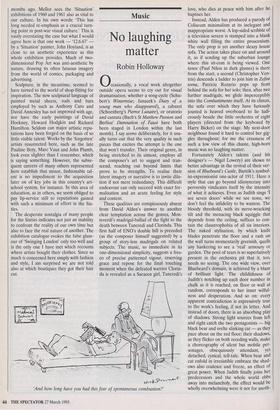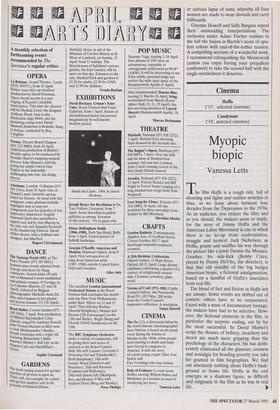Music
No laughing matter
Robin Holloway
0 ccasionally, a vocal work altogether outside opera seems to cry out for visual dramatisation, whether a song-cycle (Schu- bert's Winterreise; Janacek's Diary of a young man who disappeared), a cabaret (Schoenberg's Pierrot Lunaire), or oratorio and cantata (Bach's St Matthew Passion and Berlioz' Damnation of Faust have both been staged in London within the last month). I say seems deliberately, for it usu- ally turns out that the very quality in such pieces that excites the attempt is the one that won't transfer. Their original genre, in being stretched to its utmost, employs all the composer's art to suggest and tran- scend, reaching out beyond limits that prove to be strengths. To realise their latent imagery or narrative is to invite dilu- tion if not mere redundancy. This difficult endeavour can only succeed with exact for- malisation and an acute feeling for style and content.
These qualities are conspicuously absent from David Alden's answer to another clear temptation across the genres, Mon- teverdi's madrigal-ballad of the fight to the death between Tancredi and Clorinda. This first half of ENO's double bill is preceded (as the composer himself suggested) by a group of story-less madrigals on related subjects. The music, so immediate in its one-dimensional simplicity, suggests a fres- co of precise patterned vigour, reserving grace and repose for the final touching moment when the defeated warrior Clorin- da is revealed as a Saracen girl, Tancredi's 'And how long have you had this fear of spontaneous combustion?' love, who dies at peace with him after he baptises her.
Instead, Alden has produced a parody of Coliseum minimalism at its inelegant and inappropriate worst. A lop-sided scribble of a television screen is stamped into a blank white wall filling the entire proscenium. The only prop is yet another sleazy house sofa. The action takes place on and around it, as if sending up the suburban lounge where this sit-com is being viewed. One tenor (Paul Nilon in dark glasses) is there from the start, a second (Christopher Ven- tris) descends a ladder to join him in Zefira torna, Patricia Rozario pops up from behind the sofa for her solo; then, after two further madrigals, we glide imperceptibly into the Combattimento itself. At its climax, the sofa over which they have furiously jousted is heaved overboard to lie ludi- crously beside the little orchestra of eight players (directed from the keyboard by Harry Bicket) on the stage. My next-door neighbour found it hard to control her gig- gles throughout; for me the crassness of such a low view of this chaste, high-born music was no laughing matter.
Fortunately Alden's talents (and his designer's — Nigel Lowery) are shown to better advantage in the revival of their ver- sion of Bluebeard's Castle, Bartok's symbol- ist-expressionist one-actor of 1911. Here a style that can go beyond idiosyncrasy into perversity vindicates itself by the intensity of what it achieves. Even as Judith sings 'I see seven doors' while we see none, we don't feel the infidelity to be wanton. The bloody threshold, with its nerve-wracking tilt and the menacing black squiggle that depends from the ceiling, suffices to con- tain the claustrophobia of all six interiors. The naked stylisation, by which knife blades penetrate the floor and a rash on the wall turns momentarily greenish, quells any hankering to see a 'real' armoury or garden. The pool of tears is so superlatively present in the orchestra pit that it, too, needs no seeing. The one wide view, over Bluebeard's domain, is achieved by a blaze of brilliant light. The childishness of Judith's notching up each door number in chalk as it is reached, on floor or wall at random, corresponds to her inner wilful- ness and desperation. And so on: every apparent contradiction is expressively true to the work's feeling, if not its letter. And instead of doors, there is an absorbing play of shadows. Strong light sources from left and right catch the two protagonists — big black bear and svelte slinking cat — as they pace about on the red floor; their shadows, as they flicker on both receding walls, make a choreography of silent but mobile per- sonages, obsequiously attendant, yet detached, cynical, tell-tale. When bear and cat enfold in irresistible embrace the shad- ows also coalesce and freeze, an effect of great power. When Judith finally joins her predecessors and the whole world ebbs away into melancholy, the effect would he wholly overwhelming were it not for anoth-
er curious lapse of taste, whereby all four women are made to wear shrouds and carry billboards.
Gwynne Howell and Sally Burgess repeat their outstanding interpretations. The orchestra under Adam Fischer realises to the full the fusion in BartOk's score of opu- lent colour with end-of-the-tether tension. A compelling account of a wonderful work. I recommend relinquishing the Monteverdi (unless you enjoy having your prejudices confirmed) to take the second half with the single-mindedness it deserves.



























































 Previous page
Previous page